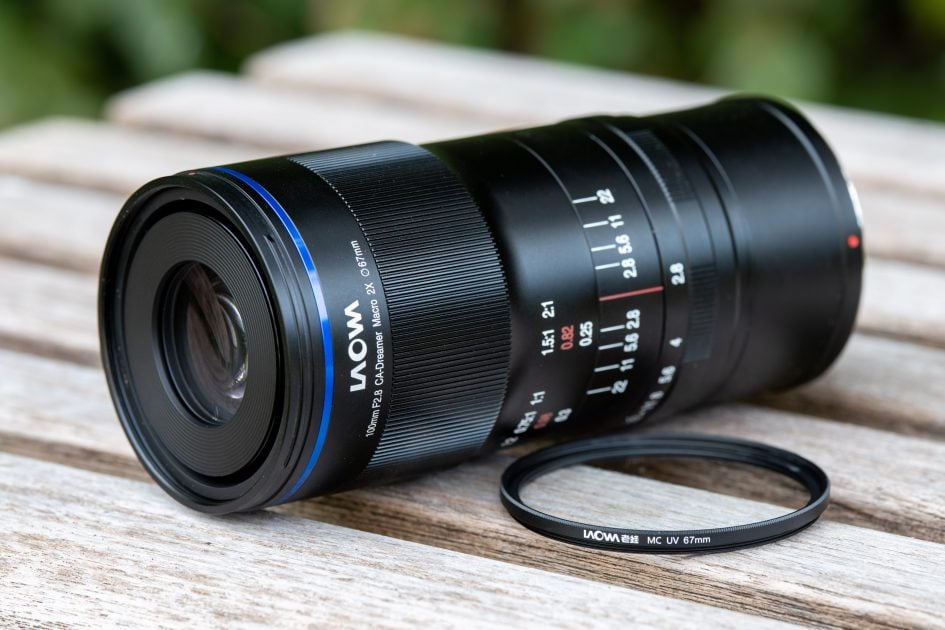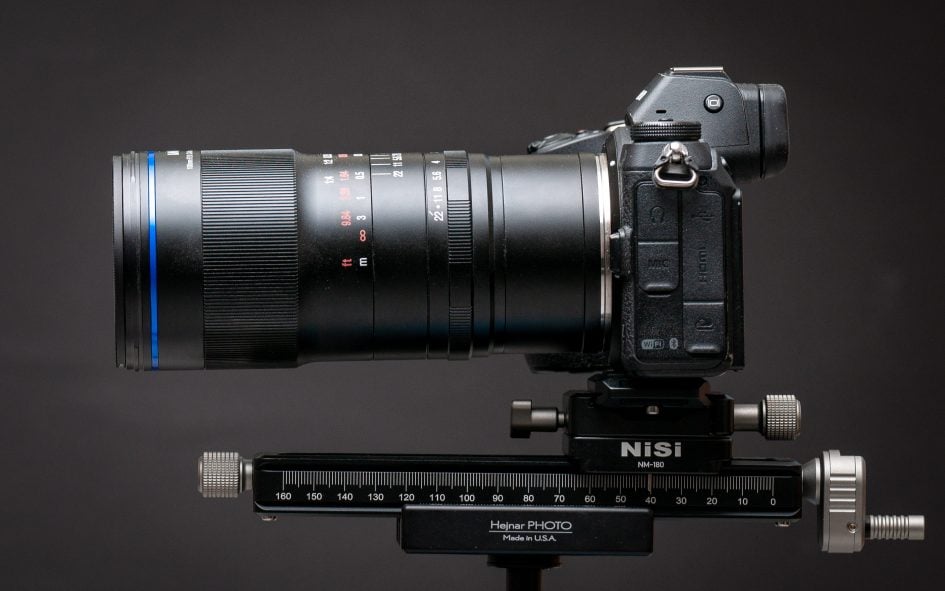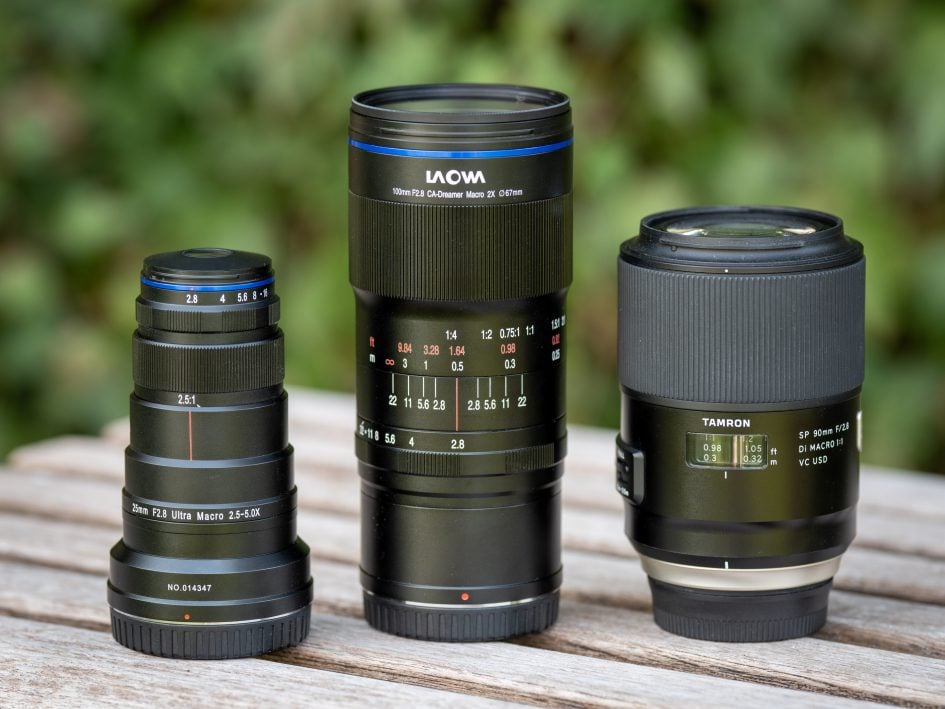Laowa 100mm f2.8 2x Macro APO review
-
-
Written by Thomas
Intro
The Laowa 100mm f2.8 2x Macro APO from Venus Optics is one of very few macro lenses which can focus from infinity to 2x magnification. Most “standard” macro lenses can achieve only 1:1 (1x) magnification without the use of bellows or extension tubes. The lens is corrected for full-frame cameras and can fill the frame with a subject of 12 x 18mm (0.47 x 0.71in.) at 2x magnification. The Laowa 100mm f2.8 2x Macro APO is manual focus only. And except for the Canon EF version the aperture also has to be operated manually and the lens does not transmit EXIF data to the camera.
The Laowa 100mm f2.8 2x Macro APO is available for Canon EF & RF, Nikon F & Z, Pentax K, Sony FE, and Leica L mounts and costs about 500 EUR / 450 USD / 470 GBP.
Above: Laowa 100mm f2.8 2x Macro APO plus supplied clear UV filter. Laowa recommends to leave the filter on at all times.
Facts and features
Let’s compare the Laowa 100mm f2.8 2x Macro APO (“Laowa” for short) to the Sigma 105mm f2.8 DG DN Macro Art (“Sigma Art”). As usual I’ve rated the features with a [+] (or [++]), when it’s better than average or even state of the art, a [0] if it’s standard or just average, and [-] if there’s a disadvantage. Size and weight were measured for the Nikon Z-mount version of the lens – which is roughly similar for all mirrorless mounts. The DSLR versions of the lens are about 30mm shorter and 15g lighter.
Size (diameter x length): 72 x 159mm (2.8 x 6.3in.) including the supplied UV filter plus 51mm for the lens hood (92mm diameter). This makes the Laowa clearly longer than the Sigma Art at 75 x 136mm + 57mm lens hood which already is quite a long lens. [0]
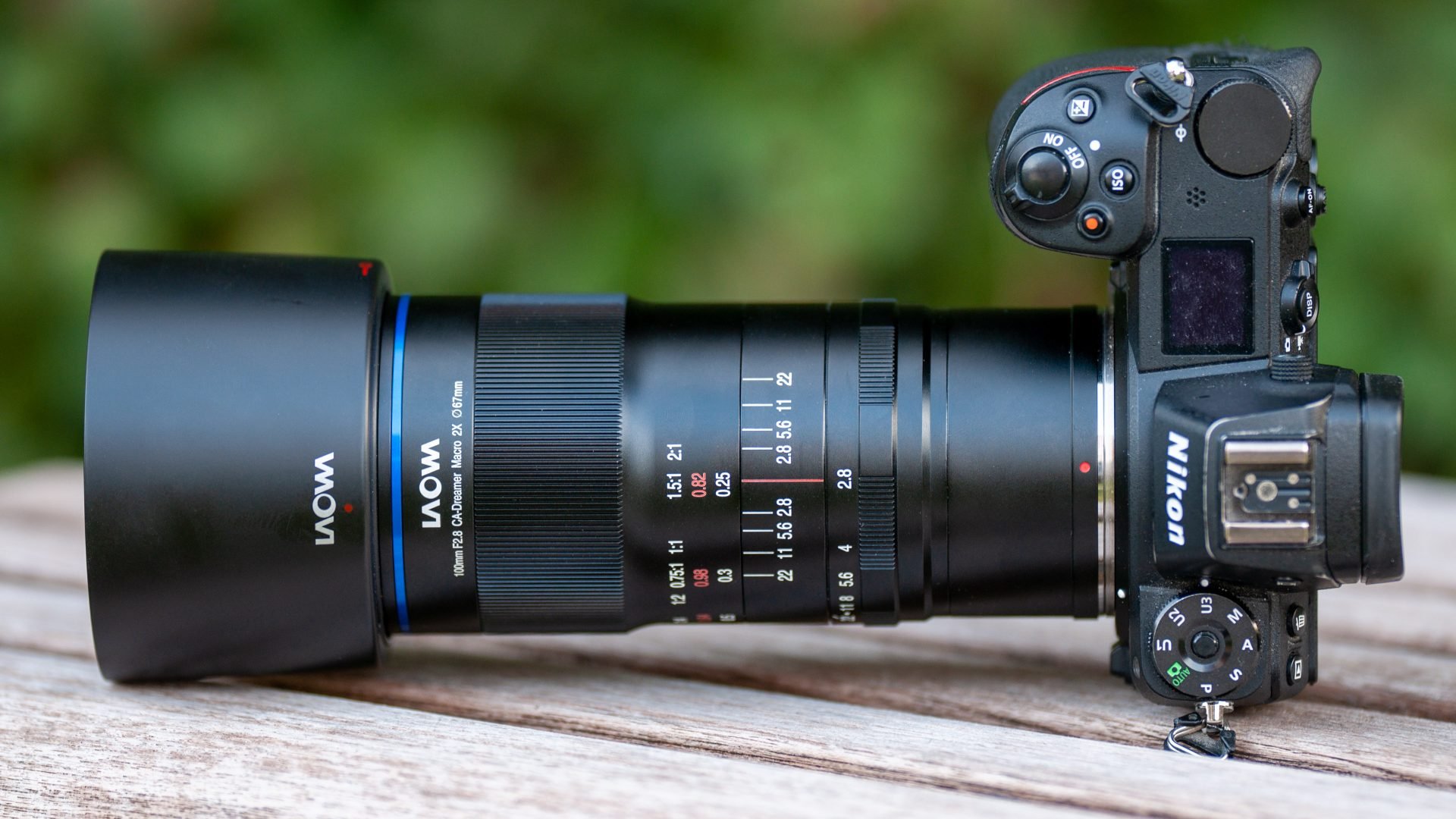
Weight: The all metal barrel brings the weigh to 700g (25 oz.) including the supplied UV filter. The plastic lens hood adds another 38g. The Sigma is 708g + 47g lens hood. [0]
Optics: The Laowa was designed to fit on DSLR cameras with their longer flange distances. It has 12 elements in 10 groups including two special dispersion elements. The Sigma Art has 17 elements in 12 groups and was specifically designed for mirrorless cameras. There’s no mention of lens coating in Laowa’s marketing material but the supplied UV filter and at least the front lens obviously have multi-layer anti-reflection coating. The Sigma Art has an additional fluorine-coating on the front element to repel water, dust, and dirt and make cleaning easier. [0]
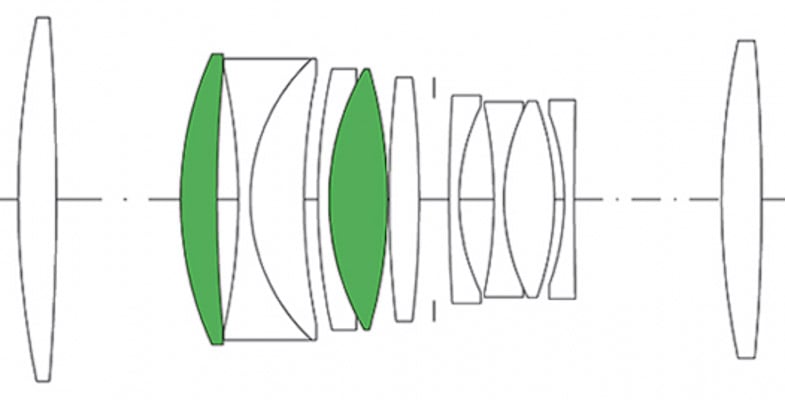
Closest focus distance is 0.25m (0.82ft.) where the Laowa reach a unique magnification of 2:1 (2x). This results in a working distance of only 0.08m (3.1in.). At 1x magnification working distance is 0.10m. The Sigma Art achieves a maximum magnification of 1:1 (1x) at a working distances of 0.15m. Both lenses do not extend while focusing. The Laowa achieves a magnification of 1:10 at a distance of 1.12m (2.9ft.), the Sigma Art at 1.24m [++]
Image stabilization: The Laowa and the Sigma Art have no optical stabilization. You only get the built-in sensor-shift stabilization which modern mirrorless camera bodies provide. As the Laowa does not provide EXIF data to the camera you should input the focal length in the camera menu (on a Nikon Z under “Non-CPU lens data”) which makes the camera stabilization work best. [0]
Filter-thread: 67mm. The Sigma Art uses 62mm filters. [+]
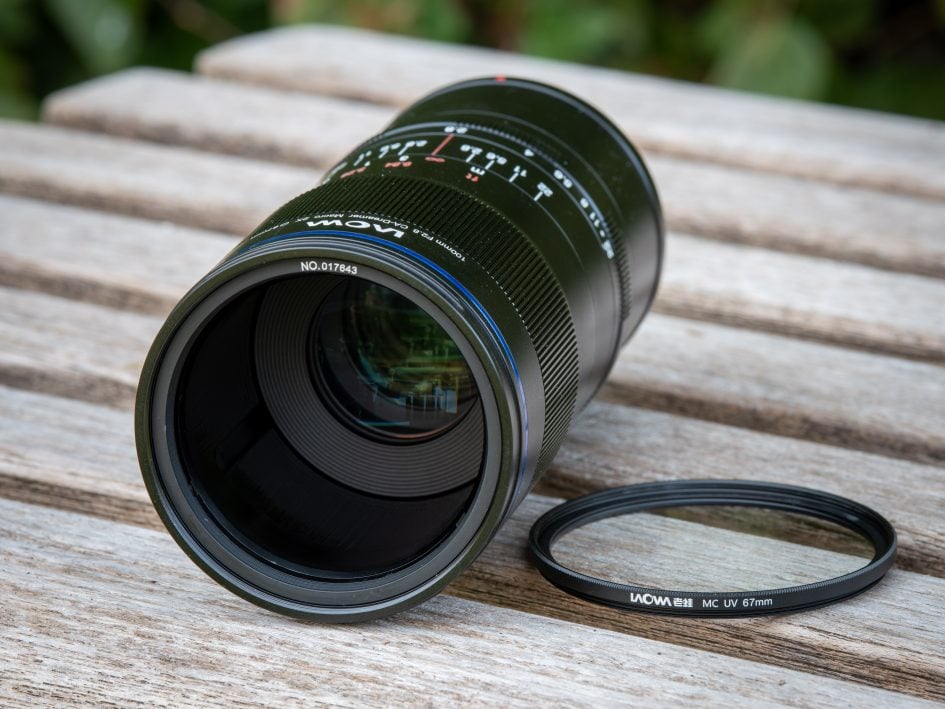
Auto focus: No, the Laowa is manual focus only. The focus ring is 55mm wide, 31mm of it a ribbed metal surface. It turns the way Nikon users are used to which is the reverse of what a Sony or Canon user expects. Operation of the focus ring requires some force – so you need not fear focus-creep when the lens is operated in a vertical position. The lens does not change it’s length but the front lens group travels 55mm inside the barrel. The focus ring has a relatively short throw of 120 degrees from infinity to 2x magnification which makes it pretty hard to focus precisely even at longer distances. The Sigma Art has the typical focus-by-wire AF you’ve come to expect from lenses designed for mirrorless cameras with a variable gearing which allows for very precise manual focus when turned slowly – even for macro shots. [-]
Focus breathing: Image become 9% more magnified when pulling focus from infinity to 1.12m (1:10 magnification). This is visible and could be distracting when shooting videos. The Sigma has slightly stronger focus breathing. [0]
Aperture: The Laowa has 13 aperture blades except for the Nikon and Pentax version (7 blades) and Canon version (9 blades). Aperture is operated manually via an aperture ring with 1 stop clicks from f2.8 to f22 and the lens does not transfer EXIF data about the aperture to the camera – except for the Canon version which has an electronically actuated aperture. The aperture ring is 25mm wide but only 8mm of it are (partially) ribbed. The clicks of the ring are a bit soft to register properly and it is easy to change aperture inadvertently. Effective f-numbers of the Laowa correspond to the nominal values shown on the aperture ring when the lens is focused to infinity. The lens loses 1 stop at 1:2 magnification, 1.7 stops at 1:1 and 2.7 stops at 2x – i.e. at 2x magnification the effective focal ratio is f7.1. This is a normal effect that most macro lenses show. Just keep in mind to use the effective f-number when calculating depth-of-field or the diffraction limit. The Sigma has an electronically operated aperture and transfers full EXIF data. It also darkens about 2 EV at 1:1 magnification. [-]
Depth of field (dof) depends on the magnification and the (effective) aperture of a lens. Wide open it is about 0.34mm/340 micron at 1x magnification and only 0.12mm/120 micron at 2x magnification. Laowa’s own dof-table in their user manual shows even shallower dof – I assume it was calculated using nominal f-numbers. Anyway, it is advisable to employ a macro-rail on a tripod to precisely focus the Laowa for close-up shots. The lens has an engraved magnification scale in addition to its distance scale. [0]
Lens profile: The lens does not come with a lens profile nor does Lightroom or Photoshop provide one. So for correcting vignetting and distortions you have to rely on manual settings in post-processing. [0]
Covers full frame/FX or smaller. Same with the Sigma. [+]
Price: 500 EUR (incl. 19% VAT) / 450 USD / 470 GBP. The Sigma Art costs 749 EUR / 799 USD / 699 GBP. [+]
The lens comes without pouch but the plastic lens hood is included and is reversible for transport – but a bit fiddly to mount. Laowa also includes a clear UV filter to protect the front of the lens construction with open cam mechanism from the elements. It is recommended to leave the filter on at all times. [0]
Sealing: No, not even a rubber grommet at the lens-mount. So if you’re shooting outdoors you should shield the lens from the elements. The Sigma Art has a rubber grommet at the lens-mount plus further special weather-sealing throughout the construction. [-]
At a score of 3[-]/8[0]/5[+] the Laowa 100mm f2.8 2x Macro APO offers the unique opportunity to reach 2x magnification at a reasonable price and a robust (albeit not weather sealed) full metal body. The missing autofocus might traditionally not be viewed as a problem in macro photography. But with the advent of focus bracketing in modern cameras autofocus made it back on the wish list for macro lenses. The manual aperture is easier to live with.
Three macro lenses for full-frame cameras
Above from left to right: Laowa 25mm f2.8 2.5-5x Ultra Macro, Laowa 100mm f2.8 2x Macro APO, Tamron 90mm f2.8 VC II (needs mount adapter for mirrorless cameras)
Alternatives
If you’re looking for macro lenses offering a magnification of at least 1:1 (1x) and focal lengths around 100mm there are a lot of alternatives. Most of them are older DSLR designs which can (still) be used via the appropriate adapter on modern mirrorless cameras. One of the cheapest lenses is from Samyang:
- The Samyang 100mm f2.8 ED UMC Makro is a DSLR design from 2015 and available in a wide variety of mounts including Sony E or mft-mount but not (yet) for Canon RF, Nikon Z or Leica L-mount. It goes down to 1x magnification and costs about 430 EUR / 500 USD / 390 GBP. Like the Laowa it has only manual focus and a manually operated aperture and does not transfer EXIF data to the camera.
If you want autofocus and a native mirrorless mount the number of alternatives slims down considerably:
- Sigma has the 105mm f2.8 DG DN Macro Art, an original mirrorless design from 2020 which can reach down to 1:1 (1x) magnification. The lens is of similar weight but over 2cm shorter than the Laowa. At 749 EUR / 799 USD / 699 GBP it is available in Sony E-mount and Leica L-mount. The lens has a de-clickable aperture ring and an AF-lock button.
- Sony’s FE 90mm f2.8 G OSS Macro is an original mirrorless design from 2015 for E-mount and costs about 960 EUR / 1050 USD / 850 GBP. It’s almost 3cm shorter and 100g lighter than Laowa’s lens. It offers optical image stabilization but it lacks an aperture ring and has a 10% shorter reach than the Laowa.
- From Tokina there’s the FiRIN 100mm 2.8 FE Macro from 2019 reaching 1x magnification. It costs 540 EUR / 600 USD / 580 GBP and is only available for Sony E-mount. It has autofocus and is quite a bit lighter and shorter than the Laowa but extends when focusing.
- Canon has the freshly announced RF 100mm f2.8 L Macro IS USM which goes down to 1.4x magnification and offers optical image stabilization plus a feature to influence Bokeh quality. Size and weight are similar to the Laowa, prices are 1550 EUR / 1400 USD / 1480 GBP.
- Nikon has not yet announced details of its upcoming Z 105mm S-Line Micro-Nikkor but it’s probably safe to assume that it has autofocus, a focal ratio of f2.8, and costs four-figures.
Next check out my quality results!
Check prices on the Laowa 100mm f2.8 2x Macro at Amazon, B&H, Adorama or WEX UK. Alternatively get yourself a copy of my In Camera book or treat me to a coffee! Thanks!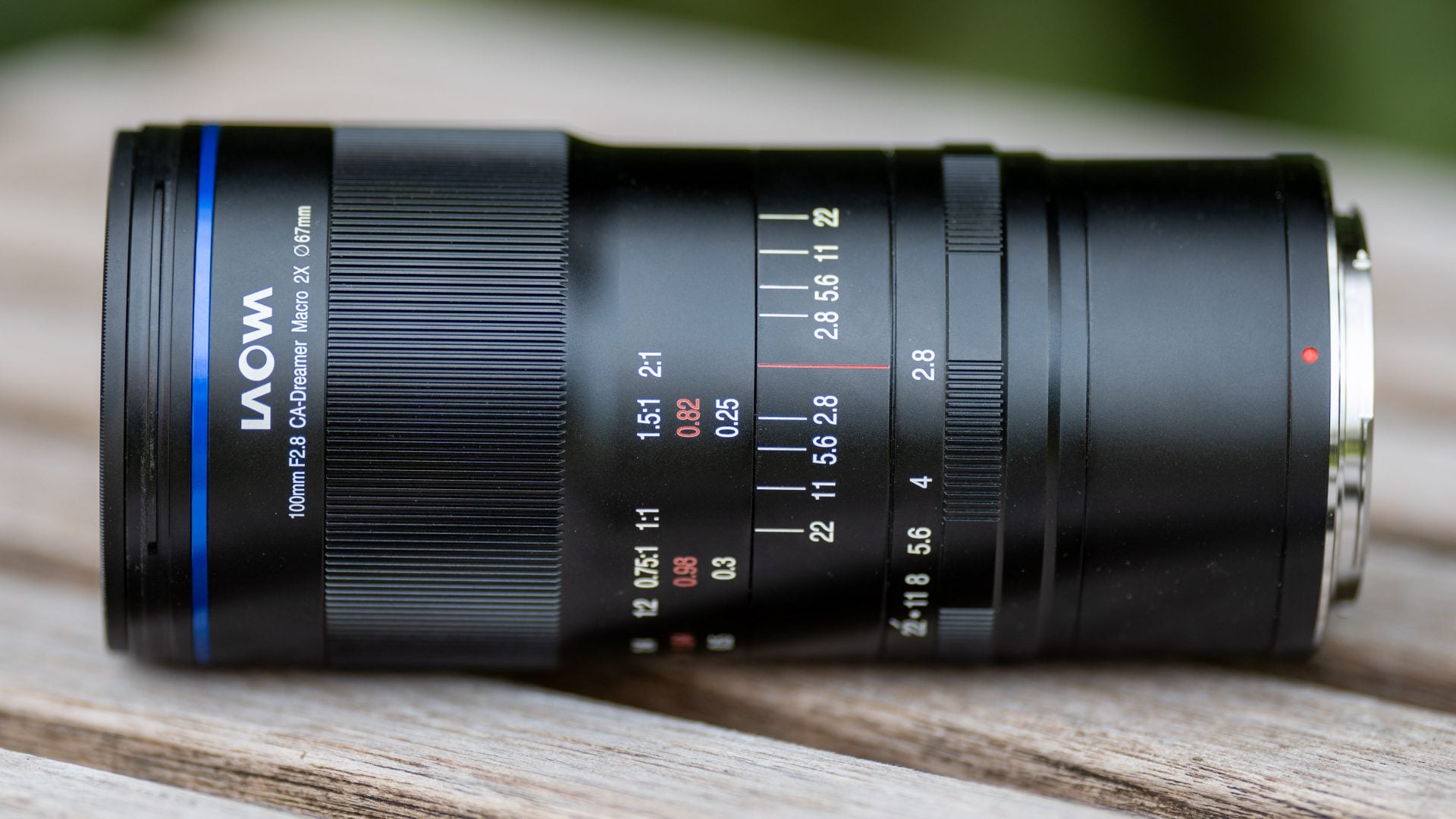
 Laowa’s 100mm f2.8 2x Macro APO is a good macro lens which also doubles up as a light telephoto. It produces sharp images with very little field-curvature – although for best results it should be stopped down a bit. It has a pretty soft Bokeh and almost no colour aberrations. But its major attraction is that the lens can focus from infinity down to 2x magnification without any additional gear – and that it comes at an affordable price. Its major drawbacks like the manual focus and aperture operation or even the vulnerability to flare and glare might not bother the hardened macro photographer working from a tripod and a focus rail. So the 100mm f2.8 2x Macro APO certainly earns a recommendation for macro work.
Laowa’s 100mm f2.8 2x Macro APO is a good macro lens which also doubles up as a light telephoto. It produces sharp images with very little field-curvature – although for best results it should be stopped down a bit. It has a pretty soft Bokeh and almost no colour aberrations. But its major attraction is that the lens can focus from infinity down to 2x magnification without any additional gear – and that it comes at an affordable price. Its major drawbacks like the manual focus and aperture operation or even the vulnerability to flare and glare might not bother the hardened macro photographer working from a tripod and a focus rail. So the 100mm f2.8 2x Macro APO certainly earns a recommendation for macro work.